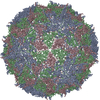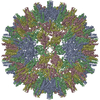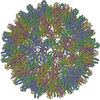[English] 日本語
 Yorodumi
Yorodumi- PDB-6itf: Icosahedral asymmetric unit (iASU) model of the less refined, coa... -
+ Open data
Open data
- Basic information
Basic information
| Entry | Database: PDB / ID: 6itf | ||||||
|---|---|---|---|---|---|---|---|
| Title | Icosahedral asymmetric unit (iASU) model of the less refined, coarse part of FHV eluted particle | ||||||
 Components Components | CAPSID PROTEIN BETA | ||||||
 Keywords Keywords |  VIRUS / VIRUS /  Flock House Virus / Disassembly intermediate / Asymmetric reconstruction Flock House Virus / Disassembly intermediate / Asymmetric reconstruction | ||||||
| Function / homology |  Function and homology information Function and homology information nodavirus endopeptidase / permeabilization of host organelle membrane involved in viral entry into host cell / symbiont entry into host cell via permeabilization of inner membrane / T=3 icosahedral viral capsid / aspartic-type endopeptidase activity / nodavirus endopeptidase / permeabilization of host organelle membrane involved in viral entry into host cell / symbiont entry into host cell via permeabilization of inner membrane / T=3 icosahedral viral capsid / aspartic-type endopeptidase activity /  proteolysis / proteolysis /  metal ion binding metal ion bindingSimilarity search - Function | ||||||
| Biological species |   Flock house virus Flock house virus | ||||||
| Method |  ELECTRON MICROSCOPY / ELECTRON MICROSCOPY /  single particle reconstruction / single particle reconstruction /  cryo EM / Resolution: 4.7 Å cryo EM / Resolution: 4.7 Å | ||||||
 Authors Authors | Banerjee, M. / Azad, K. | ||||||
| Funding support |  India, 1items India, 1items
| ||||||
 Citation Citation |  Journal: J Virol / Year: 2019 Journal: J Virol / Year: 2019Title: Structural Dynamics of Nonenveloped Virus Disassembly Intermediates. Authors: Kimi Azad / Manidipa Banerjee /  Abstract: The stability of icosahedral viruses is crucial for protecting the viral genome during transit; however, successful infection requires eventual disassembly of the capsid. A comprehensive ...The stability of icosahedral viruses is crucial for protecting the viral genome during transit; however, successful infection requires eventual disassembly of the capsid. A comprehensive understanding of how stable, uniform icosahedrons disassemble remains elusive, mainly due to the complexities involved in isolating transient intermediates. We utilized incremental heating to systematically characterize the disassembly pathway of a model nonenveloped virus and identified an intriguing link between virus maturation and disassembly. Further, we isolated and characterized two intermediates by cryo-electron microscopy and three-dimensional reconstruction, without imposing icosahedral symmetry. The first intermediate displayed a series of major, asymmetric alterations, whereas the second showed that the act of genome release, through the 2-fold axis, is actually confined to a small section on the capsid. Our study thus presents a comprehensive structural analysis of nonenveloped virus disassembly and emphasizes the asymmetric nature of programmed conformational changes. Disassembly or uncoating of an icosahedral capsid is a crucial step during infection by nonenveloped viruses. However, the dynamic and transient nature of the disassembly process makes it challenging to isolate intermediates in a temporal, stepwise manner for structural characterization. Using controlled, incremental heating, we isolated two disassembly intermediates: "eluted particles" and "puffed particles" of an insect nodavirus, Flock House virus (FHV). Cryo-electron microscopy and three-dimensional reconstruction of the FHV disassembly intermediates indicated that disassembly-related conformational alterations are minimally global and largely local, leading to asymmetry in the particle and eventual genome release without complete disintegration of the icosahedron. | ||||||
| History |
|
- Structure visualization
Structure visualization
| Movie |
 Movie viewer Movie viewer |
|---|---|
| Structure viewer | Molecule:  Molmil Molmil Jmol/JSmol Jmol/JSmol |
- Downloads & links
Downloads & links
- Download
Download
| PDBx/mmCIF format |  6itf.cif.gz 6itf.cif.gz | 106.7 KB | Display |  PDBx/mmCIF format PDBx/mmCIF format |
|---|---|---|---|---|
| PDB format |  pdb6itf.ent.gz pdb6itf.ent.gz | 78.6 KB | Display |  PDB format PDB format |
| PDBx/mmJSON format |  6itf.json.gz 6itf.json.gz | Tree view |  PDBx/mmJSON format PDBx/mmJSON format | |
| Others |  Other downloads Other downloads |
-Validation report
| Arichive directory |  https://data.pdbj.org/pub/pdb/validation_reports/it/6itf https://data.pdbj.org/pub/pdb/validation_reports/it/6itf ftp://data.pdbj.org/pub/pdb/validation_reports/it/6itf ftp://data.pdbj.org/pub/pdb/validation_reports/it/6itf | HTTPS FTP |
|---|
-Related structure data
| Related structure data |  9730MC  9732C  6itbC M: map data used to model this data C: citing same article ( |
|---|---|
| Similar structure data |
- Links
Links
- Assembly
Assembly
| Deposited unit | 
|
|---|---|
| 1 | x 60
|
| 2 |
|
| 3 | x 5
|
| 4 | x 6
|
| 5 | 
|
| Symmetry | Point symmetry: (Schoenflies symbol : I (icosahedral : I (icosahedral )) )) |
- Components
Components
| #1: Protein |  / COAT PROTEIN BETA / COAT PROTEIN BETAMass: 39367.355 Da / Num. of mol.: 3 Source method: isolated from a genetically manipulated source Source: (gene. exp.)   Flock house virus / Gene: alpha / Cell line (production host): DL-1 / Production host: Flock house virus / Gene: alpha / Cell line (production host): DL-1 / Production host:   Drosophila melanogaster (fruit fly) / References: UniProt: P12870, Drosophila melanogaster (fruit fly) / References: UniProt: P12870,  nodavirus endopeptidase nodavirus endopeptidase |
|---|
-Experimental details
-Experiment
| Experiment | Method:  ELECTRON MICROSCOPY ELECTRON MICROSCOPY |
|---|---|
| EM experiment | Aggregation state: PARTICLE / 3D reconstruction method:  single particle reconstruction single particle reconstruction |
- Sample preparation
Sample preparation
| Component | Name: Flock house virus Nodavirus endopeptidase / Type: VIRUS Nodavirus endopeptidase / Type: VIRUSDetails: Purified wildtype Flock House Virus heated to 70 degC Entity ID: all / Source: RECOMBINANT |
|---|---|
| Molecular weight | Value: 9 MDa / Experimental value: YES |
| Source (natural) | Organism:   Flock house virus Flock house virus |
| Source (recombinant) | Organism:   Drosophila melanogaster (fruit fly) Drosophila melanogaster (fruit fly) |
| Details of virus | Empty: NO / Enveloped: NO / Isolate: SPECIES / Type: VIRION |
| Natural host | Organism: Costelytra zealandica |
| Virus shell | Diameter: 300 nm / Triangulation number (T number): 3 |
| Buffer solution | pH: 7 |
| Buffer component | Conc.: 50 mM / Name: HEPES / Formula: C8H18N2O4S / Formula: C8H18N2O4S |
| Specimen | Conc.: 1.5 mg/ml / Embedding applied: NO / Shadowing applied: NO / Staining applied : NO / Vitrification applied : NO / Vitrification applied : YES : YESDetails: Purified wildtype Flock House Virus heated to 70 degC |
| Specimen support | Grid material: COPPER / Grid mesh size: 400 divisions/in. / Grid type: Quantifoil R2/2 |
Vitrification | Instrument: FEI VITROBOT MARK IV / Cryogen name: ETHANE / Humidity: 100 % / Chamber temperature: 284 K / Details: Blot for 3 seconds before plunging |
- Electron microscopy imaging
Electron microscopy imaging
| Experimental equipment |  Model: Titan Krios / Image courtesy: FEI Company |
|---|---|
| Microscopy | Model: FEI TITAN KRIOS |
| Electron gun | Electron source : :  FIELD EMISSION GUN / Accelerating voltage: 300 kV / Illumination mode: FLOOD BEAM FIELD EMISSION GUN / Accelerating voltage: 300 kV / Illumination mode: FLOOD BEAM |
| Electron lens | Mode: BRIGHT FIELD Bright-field microscopy / Nominal magnification: 81000 X / Nominal defocus max: 3000 nm / Nominal defocus min: 500 nm / Cs Bright-field microscopy / Nominal magnification: 81000 X / Nominal defocus max: 3000 nm / Nominal defocus min: 500 nm / Cs : 2.7 mm : 2.7 mm |
| Specimen holder | Cryogen: NITROGEN / Specimen holder model: FEI TITAN KRIOS AUTOGRID HOLDER |
| Image recording | Average exposure time: 5 sec. / Electron dose: 20 e/Å2 / Detector mode: COUNTING / Film or detector model: GATAN K2 SUMMIT (4k x 4k) / Num. of grids imaged: 2 / Num. of real images: 2835 |
| EM imaging optics | Energyfilter name : GIF Quantum LS : GIF Quantum LS |
| Image scans | Movie frames/image: 40 |
- Processing
Processing
| EM software |
| ||||||||||||||||||||||||||||
|---|---|---|---|---|---|---|---|---|---|---|---|---|---|---|---|---|---|---|---|---|---|---|---|---|---|---|---|---|---|
CTF correction | Type: PHASE FLIPPING AND AMPLITUDE CORRECTION | ||||||||||||||||||||||||||||
| Particle selection | Num. of particles selected: 61905 / Details: Manual selection | ||||||||||||||||||||||||||||
| Symmetry | Point symmetry : C1 (asymmetric) : C1 (asymmetric) | ||||||||||||||||||||||||||||
3D reconstruction | Resolution: 4.7 Å / Resolution method: FSC 0.143 CUT-OFF / Num. of particles: 58918 / Algorithm: FOURIER SPACE / Num. of class averages: 30 / Symmetry type: POINT | ||||||||||||||||||||||||||||
| Atomic model building | B value: 181 / Protocol: OTHER / Space: REAL | ||||||||||||||||||||||||||||
| Atomic model building | PDB-ID: 4FTB Accession code: 4FTB / Source name: PDB / Type: experimental model |
 Movie
Movie Controller
Controller










 PDBj
PDBj

